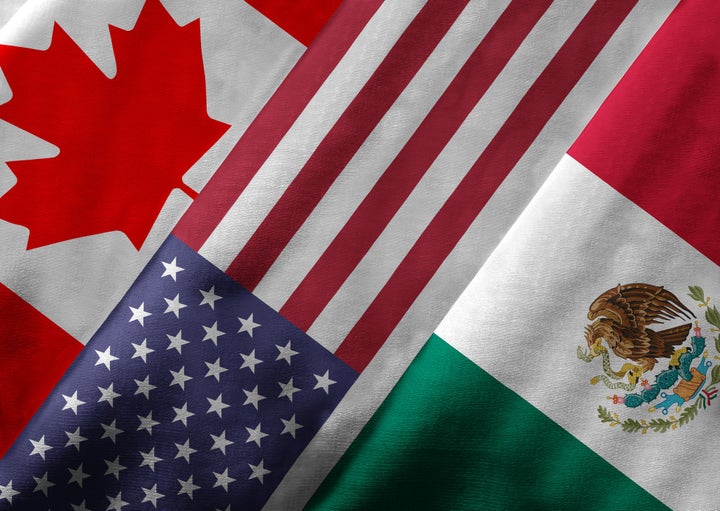
There is no great need to renegotiate NAFTA. Most of its flaws or omissions would have been corrected by the TPP negotiations, which established new trade rules for 12 countries in the Pacific region, including Canada, Mexico, and the United States. Nevertheless, having withdrawn from the TPP, the Trump administration is now pushing for a NAFTA renegotiation. To make the best of the situation, here are some items for consideration if a renegotiation goes forward, broken down into three categories: Things to avoid; things that would actually improve the agreement; and things that are either politically useful or necessary. If we do this right, we could actually improve NAFTA and promote North American economic integration.
First, in the category of things to avoid, any renegotiation should take tariffs off the negotiating table. One of the most important achievements of NAFTA was to create a North American trading zone that is free of almost all tariffs. Tariff-free trade between the three countries has helped encourage an integrated manufacturing area, in which different stages of production can take place in different countries. Raw materials from one country might be shipped to another country for initial processing, and then on to another for final assembly. This has led to more efficient manufacturing, which makes North American companies more competitive, and gives North American consumers higher quality products at lower prices. Any NAFTA renegotiation should not touch tariffs.
Turning to NAFTA improvements, the agreement was negotiated in the early 1990s, when the internet was in its infancy, and therefore its liberalization of services that can be provided online is minimal. The parties should open up the services provisions and look for opportunities to remove restrictions on trade in online services. Along the same lines, a NAFTA renegotiation should add new rules on e-commerce. The TPP has a chapter on these issues, which could serve as the basis for a new NAFTA chapter.
NAFTA can also push forward on regulatory cooperation. Regulatory cooperation councils already exist between the United States and both Canada and Mexico, outside the context of NAFTA. NAFTA could incorporate these issues into the agreement itself. To be clear, this would not be regulatory harmonization. Rather, there would be a process through which companies of one country could make requests of other governments for mutual recognition in relation to testing and certification of goods and services.
As another improvement, the core state to state dispute procedure in Chapter 20 has not functioned in recent years because governments who are faced with complaints can block the establishment of a panel. The TPP dispute chapter has provisions that overcome this deficiency. The NAFTA renegotiations should consider adopting these TPP provisions, or something similar. If the NAFTA provisions cannot be enforced with effective dispute procedures, they are of little value.
“Despite being a target of anti-globalization angst, NAFTA has been a success, and a return to pre-NAFTA trade barriers would be extremely harmful to all three economies.”
Lastly, there are several possible NAFTA changes that could be politically useful or necessary. There may not be a great need for change, but there will be demands by influential interest groups that will be hard to ignore.
A special dispute provision, in Chapter 19, allows foreign companies or governments who are subject to anti-dumping or countervailing duties to appeal government agency decisions to a NAFTA panel rather than to a domestic court in order to determine consistency with U.S. law. Such a procedure may not be consistent with the U.S. Constitution (it has been challenged in U.S. courts, but no final decision was ever reached), and even without the procedure, foreign governments have the ability to challenge agency decisions at the WTO. Taking Chapter 19 out would satisfy a number of U.S. industry critics of NAFTA.
Another dispute provision is in Chapter 11, which allows foreign investors to bring disputes against host governments in an international tribunal. This provision causes a great deal of controversy, with many people on the left expressing concern that it undermines domestic regulation, and some on the right worrying about lost sovereignty. This controversy, combined with the weak tie to liberalization (the evidence that this type of provision facilitates investment is mixed), suggests that this provision could be taken out, although business groups will fight hard to keep it.
There have also been interest group demands to tighten up rules of origin, in particular for automobile manufacturing, and to strengthen the rules on labor and environment protections. It will be difficult to avoid addressing these issues in a NAFTA renegotiation. For the labor and environment protections, borrowing from the TPP chapters on these issues could be the easiest way forward.
Despite being a target of anti-globalization angst, NAFTA has been a success, and a return to pre-NAFTA trade barriers would be extremely harmful to all three economies. As a result, the idea of a renegotiation might scare some NAFTA supporters. However, it might actually be an opportunity to reinvigorate North American economic integration. Not long ago, there were concerns that the TPP would undermine this integration. Now that a NAFTA renegotiation has been forced upon us, we should embrace the chance to bring NAFTA into the 21st century.